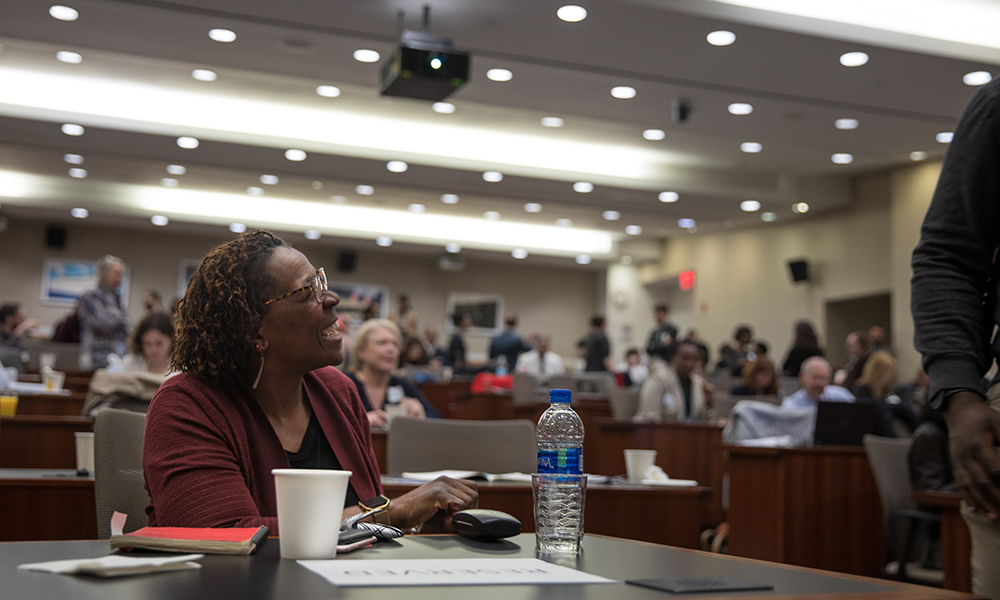NEW YORK — When the moderator informally polled the audience at a criminal justice discussion held at the New York Law School on whether probation and parole should be abolished, almost half the audience — mostly criminal justice practitioners and stakeholders — raised their hands.
 “Look at that,” said Vincent Schiraldi, a former city department of probation commissioner, sounding both surprised and pleased by the response.
“Look at that,” said Vincent Schiraldi, a former city department of probation commissioner, sounding both surprised and pleased by the response.
“I’m at best a real minimalist on probation and parole,” he said, “I think we need to ask very elemental question about their existence.”
Some of the views exchanged at the Monday event were bold: Perhaps abolishing jails and prisons. Perhaps abolishing the police.
The panelists, which included Manhattan District Attorney Cyrus Vance, had wide-ranging conversations about the reforms and policy shifts they say ushered an unprecedented and simultaneous decline in arrests, summonses and jail population — all while the city is experiencing its lowest crime rate in four decades.
To bring that about was the combined effort of several moving pieces, the experts said.
“What I see is we have service providers and grassroots advocates fighting for less incarceration. We have open-minded and increasingly educated department officials, including judges and prosecutors, and probation commissioners,” Schiraldi said.
“It’s absolutely a story, an untold story, and I think that a lot of New Yorkers don’t even know it’s happening.”
In the last five years, arrests have fallen by 37%. Criminal summonses dropped by 79%. Stop-question-and-frisk encounters have declined by 94%. The jail population is as low as it was in 1976, when the crime rate in the city was four times higher.
Strong numbers, but not causality
Some of the biggest improvements in the system, the panelists said, was in juvenile justice.
In 2000, Family Court in New York City sent about 4,000 young people to state prisons. Now, no youths get detained in state prisons and only 19 are currently under any kind of lockup custody across the city, spread among five facilities where they don’t spend more than 90 days. A decade ago, such numbers would have been unthinkable, the experts said.
Those facilities, like Crossroads Juvenile Detention Center in Brooklyn, have allowed youth to avoid prison sentences, which too often mean the beginning of a downward spiral for the justice-involved young.
Judge Edwina Mendelson, a Gov. Andrew Cuomo appointee who now supervises the implementation of the Raise the Age law, said that was “what we should have done many and many years ago.”
Even the number of children in foster care has fallen sharply. In the 1990s, there were about 40,000 children in foster care in New York City. Today, the number is under 9,000.
But while the numbers show New York City is shifting gears on criminal justice reform, much harder is to establish, the experts said, is whether new policies are causing the drop in crime or whether they are a consequence of it.
Crime numbers have been decreasing for a long time nationwide, and even worldwide, said Jeffrey Butts, a professor who leads the Research and Evaluation Center at John Jay College of Criminal Justice. He has researched the juvenile justice system since the late 1980s.

Judge Edwina Mendelson, deputy chief administrative judge for the Office of Justice Initiatives, at the New York City panel discussion Monday.
He said New York’s falling crime rates and number of arrests reduced the pressure on the rest of the system to be punitive. In response, they’ve been experimenting with more diversion.
Social workers and criminal justice researchers pointed to various practices that might be responsible for the outcome: diversion rather than jail, community supervision rather than jail, grassroots approach rather than a top-down centralized one, emboldened public defenders.
“They danced around attributing causality. Everyone wanted to claim their own cause,” Butts said.
Divestment + investment
All the panelists agreed that the most promising solutions are those driven by the work of nonprofits providing alternatives to incarceration and diversion programs.
Eric Cumberbatch, the executive director of the Mayor’s Office to Prevent Gun Violence, talked about a gun violence reduction program his office created from scratch with the input of youth adversely impacted by gun violence on either side, perpetrator or victim.
“We employ these young people who could be outside getting hurt, hurting others, or doing other destructive things,” Cumberbatch said. “And when we have them in an employment program — guess what — they show up every day.”
The Anti-Gun Violence Employment Program, which began in 2015, employs about 400 people, most of them formerly incarcerated, whose role of “credible messengers” and “violence interrupters” has helped the number of shootings in certain neighborhoods decline by 15%.
“What has started as an anti-gun violence initiative has morphed into a reintegration initiative, a recidivism reduction initiative, because the workforce is not being arrested and they aren’t reoffending at the rate of their counterpart, and a gun violence reduction strategy,” Cumberbatch said.
Vivian Nixon, executive director of the College and Community Fellowship, said a divestment from law enforcement and an investment in education work best at reducing crime.
“Our greatest tool against recidivism is to reinvest money that we’re not going to spend in a massive criminal justice system into a massive state of the arts best-in-the-world education system from birth to any level of higher education that people want,” said Nixon, whose nonprofit helps women with criminal justice histories pay for their higher-education degrees.
Butts said the justice system in New York City should take advantage of the nonprofit sector and community-based resources that are bringing the focus to the needs of community to take care of itself, and steer the solution away from police and prosecution.
“I like the idea behind the credible messengers approach. I think it’s great,” Butts said. “Especially adolescents, they listen to each other and listen to people who understand them more than they listen to adults, especially authority figures.”
But he cautioned the model risks being “overhyped and oversold” or becoming a fad or a sort of all-purpose solution.
“My concern is always: Have we really learned our lesson and changed our instincts about justice?” he said. “Or if we start to see numbers going back up, will we go through the same thing again?”
